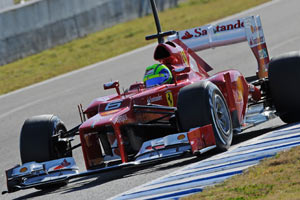Postmoe wrote:I've been lurking this thread several weeks until I decided to register and say something...
I've read a lot of posts about multiple issues, flaws, bad designs, correlation problems, idiotic management, lack of elipses.
Well, I'm no aero or mechanical engineer so perhaps my opinion would have less weight, even if engineers are only the clerks in a complex process of management and implementation. I'm aware of that.
My theory, a very simple one, is not related to engineering in a direct way. It's more "managerial" and economic if you like, and can be resumed with one simple clean concept:

Lets make an enumeration of elements that will be connected to different leraning curves at Ferrari.
From general to specific.
Part one:
- New employees and new methods
- New tools
- New materials
Part two:
- New whole car concept
- New chasis
- New tyres
Part three:
- New front suspension, with new dampers, springs, and needs (new set up)
- New rear suspension, with new dampers, springs, and needs (new set up plus bodywork)
- New cooling system
- New floor
- New FW
- New DRS
- New specific aero main fluxes around bodywork
I'm pretty sure I forgot plenty of things, it doesn't matter.
First idea:
Who in this world could think they had real possibilities of being competitive from day one if they acumulated 3 o 4 issues in their 50 potential learning issues element list?
Second idea:
Who in this world could think that a logical number of issues should be the end of the whole project?
I think that, given the huge amount of new ideas/elements put to work in the car no WT or CFD software could garantee a faultless implementation, it would mean prediction levels that are far beyond our XXIth century means.
The normal learning curve issue possibilities are so high that we can't know if problems are caused by "normal" learning processes or design flaws. It's simply impossible to know. I bet they're not even capable of making a clear differentiation at this moment in Ferrari.
One or two extra races are going to be necessary to START to see wich things won't ever work. What you simply can't know is that a front pull-rod configuration won't work in a context were you had to change exhaust position in a daily basis. Too much data could be inconsistent and correlations could be hard to isolate without big margins of error. In a car you can't use extensively ways to cope with margins of error like in complex polls.
What I think Ferrari should do is calm down and continue their development/implementation program only changing obvious elements that plainly didn't work. To start making steps backwards only for fear would be the worst thing to do. At the moment it's very difficult that they can find certainty in most of the new things they are learning to put on competition working rates. I remember the constant issues that RB had in every race in 2010, years after they started their development path. Had they stopped in 2009, they would have never known victory.
We'll see.
PS: Perhaps I am naïf and engineers are überhumans that one day simply had enough with innacuracy and acomplished what others couldn't. As I said, I'm no engineer and perhaps in a forum we really can know with a couple of pics and the eliptic shape of a coke bottle. Beg you pardon if it's true.














